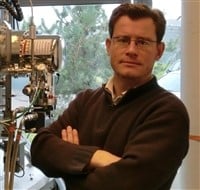
Dr. Olivier Douhéret received its Civil Engineering degree in Physics from the Polytechnic National Institute of Grenoble (INPG), France in 2000. He then accomplished his doctoral studies in Material Physics at the Royal Institute of Technology (KTH) of Stockholm, Sweden and graduated in 2004.
His first postdoctoral position was accomplished within the IMEC division of the Institute for Materials (IMO) in Diepenbeek, Belgium. In 2007, he joined Materia Nova R&D Center as research scientist where he has been working ever since.
From PhD studies to current activities, his field of work progressively expanded from conventional inorganic to organic semiconducting materials and technology and from high resolution electrical characterization-based scanning probe microscopy methods towards fabrication and characterization of organic electronic structures such as electroluminescent and photovoltaic devices.
His past and current collaborations lie both within academic societies and industrial partnerships.
Application of Modelling Tools for the Electrical Characterisation of Organic Semiconductors
With the discovery of (semi)conducting properties in organic materials, organic electronics have progressively emerged as a complementary technology to microelectronics. Organic semiconductors now compose several key electronic devices to be considered for IoT applications, with added value such as large scale and low production cost, mechanical flexibility, and low environmental footprint. While industrial developments are taking longer time to happen due to crucial challenges still to be overcome, academic research has been exhibiting an ongoing enthusiasm in the field, sustained by the huge diversity of materials to be studied [1]. Especially, unravelling the conductive properties in these materials remains an open and complex challenge ought to the different mechanisms likely to impact the charge transport, even further leveraged by the diversity of materials. The current solid and powerful modelling tools offered by quantum chemistry is driving the molecular design and synthesis for ultimate performance at atomistic and molecular scales [2]. At mesoscopic scale and beyond, different (semi-)empirical models independently shaped out with time from experimental protocols and associated physical formalisms. This results into large disparities in the estimation of key semiconducting properties of the materials, typically the carrier mobility, thus questioning the pertinence of the existing models and striking the need of consistency in modelling endeavours likely to serve the disentanglement of the different mechanisms contributing to charge transport in bulk materials.
This work proposes to illustrate such challenge for the modelling of bulk carrier transport in a reference semiconducting polymer (poly-3-hexylthiophene, P3HT [1]) coordinating different experimental protocols with their different probing scales and mechanisms. The amorphous or bare polycrystalline organization of organic semiconducting thin films fosters dominating charge hopping among transport mechanisms. The resulting carrier mobilities are sufficiently low to make the material exhibiting space charge limited current (SCLC) regime upon low electric field [3]. Associated models are analytically derived considering drift and diffusion equations and the geometry of the device under test. Their suitability for the determination of carrier mobility is demonstrated for a macroscopic and planar hole-only device geometry and a nanoscale hemispherical tip-sample contact configuration [4]. SCLC is evidenced and consistent carrier mobility is determined evidencing similar leading transport mechanisms in bulk P3HT down to the mesoscale. The derived values are shown to describe interchain transport in the orthogonal π-stacking of the polymer backbone [5]. Exploring intrachain transport can be carried out using microwave characterisation methods [1], which typical operating frequencies correspond to temporal response of polaronic transport. Dielectric resonators and scanning microwave microscopy recently demonstrated sensitivity to variations of electrical properties in polythiophene, at the macro- and nanoscale, respectively [6,7]. In dielectric resonator, standard Maxwell model is augmented data filtering to derive the complex permittivity of the material and prepared to be coupled to drift-diffusion in further work. In SMM, a home-made analytical model considering the interferometer-based detection unit is currently under validation to also derive locally the complex permittivity. Comparing intrachain and interchain bulk electrical properties shall then serve for material screening to determine their ultimate bulk performances and evaluate the fabrication and integration in electronic devices.